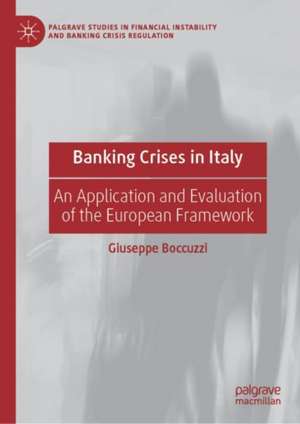Banking Crises in Italy: An Application and Evaluation of the European Framework: Palgrave Studies in Financial Instability and Banking Crisis Regulation
Autor Giuseppe Boccuzzien Limba Engleză Hardback – 27 aug 2022
| Toate formatele și edițiile | Preț | Express |
|---|---|---|
| Paperback (1) | 627.82 lei 6-8 săpt. | |
| Springer International Publishing – 28 aug 2023 | 627.82 lei 6-8 săpt. | |
| Hardback (1) | 632.01 lei 6-8 săpt. | |
| Springer International Publishing – 27 aug 2022 | 632.01 lei 6-8 săpt. |
Preț: 632.01 lei
Preț vechi: 743.54 lei
-15% Nou
Puncte Express: 948
Preț estimativ în valută:
121.01€ • 126.01$ • 100.40£
121.01€ • 126.01$ • 100.40£
Carte tipărită la comandă
Livrare economică 13-27 februarie
Preluare comenzi: 021 569.72.76
Specificații
ISBN-13: 9783031013430
ISBN-10: 3031013433
Pagini: 259
Ilustrații: XX, 259 p. 46 illus., 44 illus. in color.
Dimensiuni: 148 x 210 mm
Greutate: 0.49 kg
Ediția:1st ed. 2022
Editura: Springer International Publishing
Colecția Palgrave Macmillan
Seria Palgrave Studies in Financial Instability and Banking Crisis Regulation
Locul publicării:Cham, Switzerland
ISBN-10: 3031013433
Pagini: 259
Ilustrații: XX, 259 p. 46 illus., 44 illus. in color.
Dimensiuni: 148 x 210 mm
Greutate: 0.49 kg
Ediția:1st ed. 2022
Editura: Springer International Publishing
Colecția Palgrave Macmillan
Seria Palgrave Studies in Financial Instability and Banking Crisis Regulation
Locul publicării:Cham, Switzerland
Cuprins
Chapter 1: Introduction.- Part I: The management of banking crises in Italy: old and new solutions in a framework of increasing complexity.- Chapter 2: The overall picture. System weaknesses and individual problems.- Chapter 3: The Tercas case: a watershed.- Chapter 4: The first application of the BRRD: the case of the four banks in resolution.- Chapter 5: Two types of public intervention: orderly liquidation and precautionary recapitalisation.- Chapter 6: Establishment of the FITD’s Voluntary Scheme and interventions carried out.- Chapter 7: The FITD’s preventive and alternative measures.- Part II: Lessons learned and the (many) open questions.- Chapter 8: How to manage the crises?.- Chapter 9: The debate on the harmonised insolvency framework in Europe.- Chapter 10: Who gets the bill in a crisis?.- Chapter 11: Public intervention in crises.- Chapter 12: Deposit Guarantee Schemes: role and functioning in bankingcrises.- Chapter 13: Conclusion: A long list of open issues.
Notă biografică
Giuseppe Boccuzzi has been the President of Banca Carige, Cassa di Risparmio di Genova e Imperia since February 2021. Previously, he has been Director General of the Interbank Deposit Protection Fund (Fondo Interbancario di Tutela dei Depositi), the Italian Deposit Guarantee Scheme from 2014 to 2020. He successfully led the transformation and reorganization of FITD in compliance with the new European Regulation on Deposit Guarantee Schemes. He has also had a long career at the Bank of Italy, the Italian Central Bank, and as a financial supervisor, where he was the Head of the Directorate of Supervision and Institutional Relations. His responsibilities were in crisis management and resolution of banks and other financial intermediaries.
Textul de pe ultima copertă
This book offers the first original study on banking crises management in Italy from 2014 to 2020 with a comprehensive overview of the resolution tools used. In Italy, the issue of banking crises is now the focus of attention, not only as a result of the cycle of crises that occurred in the years 2014-2020 but also because of the banking reform carried out in Europe with the directives on bank recovery and resolution and the implementation of the Single Resolution Mechanism and the Single Resolution Fund within the framework of the Banking Union. The Italian banking crises have been managed by applying the new European regulatory framework; in this sense they constitute a significant test to assess its effectiveness and coherence. This book, divided into two parts, makes an initial assessment of the crisis situations and the application of the new rules, and offers an initial evaluation of their functioning. In the first part, an in-depth examination is made of the various cases of crisis, following a methodology of classification by type of solution and instruments adopted. The second part is dedicated to lessons learned and open issues. In detail, the most sensitive issues of the current debate are addressed, relating to the improvement of the institutional set-up and the rules for crisis management, the harmonization of insolvency rules in Europe, the funding of resolution, public intervention and, finally, the role of deposit guarantee systems. An articulated and complex picture emerges with various areas for improvement and policy indications, offering a framework that will be of interest to scholars, researchers, professors, students and practitioners of banking and banking regulation.
Caracteristici
Offers the first and original study on banking crises management in Italy Provides a comprehensive overview of the resolution tools used Covers all banking crises in Italy from 2014 to 2020

